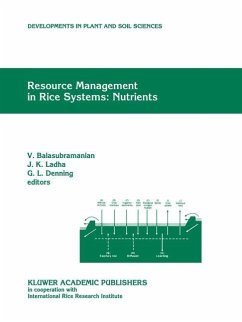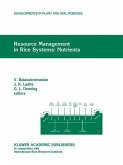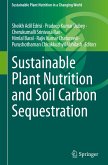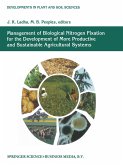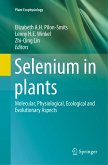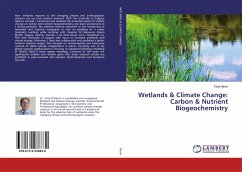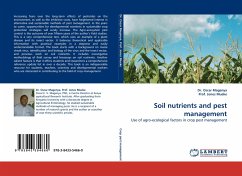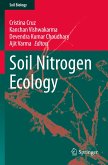Resource Management in Rice Systems: Nutrients
Papers presented at the International Workshop on Natural Resource Management in Rice Systems: Technology Adaption for Efficient Nutrient Use, Bogor, Indonesia, 2-5 December 1996
Herausgegeben:Balasubramanian, V.; Ladha, J. K.; Denning, G. L.
Resource Management in Rice Systems: Nutrients
Papers presented at the International Workshop on Natural Resource Management in Rice Systems: Technology Adaption for Efficient Nutrient Use, Bogor, Indonesia, 2-5 December 1996
Herausgegeben:Balasubramanian, V.; Ladha, J. K.; Denning, G. L.
- Broschiertes Buch
- Merkliste
- Auf die Merkliste
- Bewerten Bewerten
- Teilen
- Produkt teilen
- Produkterinnerung
- Produkterinnerung
Rice is the major staple food in Asia, and food security means rice security for most Asians. By the year 2025, we need to produce about 60% more rice than we do today to meet the growing demand. Efficient use of inputs is vital to safely produce the additional food from limited resources with minimal impact on the environment. This book reviews emerging knowledge-intensive technologies and decision aids for improved nutrient management in rice, technology adoption constraints at the farm level, and innovative approaches for field evaluation and promotion of new technologies to farmers. It is…mehr
Andere Kunden interessierten sich auch für
![Resource Management in Rice Systems: Nutrients Resource Management in Rice Systems: Nutrients]() V. Balasubramanian / J.K. Ladha / G.L. Denning (eds.)Resource Management in Rice Systems: Nutrients115,99 €
V. Balasubramanian / J.K. Ladha / G.L. Denning (eds.)Resource Management in Rice Systems: Nutrients115,99 €![Sustainable Plant Nutrition and Soil Carbon Sequestration Sustainable Plant Nutrition and Soil Carbon Sequestration]() Sustainable Plant Nutrition and Soil Carbon Sequestration129,99 €
Sustainable Plant Nutrition and Soil Carbon Sequestration129,99 €![Management of Biological Nitrogen Fixation for the Development of More Productive and Sustainable Agricultural Systems Management of Biological Nitrogen Fixation for the Development of More Productive and Sustainable Agricultural Systems]() Management of Biological Nitrogen Fixation for the Development of More Productive and Sustainable Agricultural Systems77,99 €
Management of Biological Nitrogen Fixation for the Development of More Productive and Sustainable Agricultural Systems77,99 €![Selenium in plants Selenium in plants]() Selenium in plants113,99 €
Selenium in plants113,99 €![Wetlands & Climate Change: Carbon & Nutrient Biogeochemistry Wetlands & Climate Change: Carbon & Nutrient Biogeochemistry]() Tariq MunirWetlands & Climate Change: Carbon & Nutrient Biogeochemistry51,99 €
Tariq MunirWetlands & Climate Change: Carbon & Nutrient Biogeochemistry51,99 €![Soil nutrients and pest management Soil nutrients and pest management]() Oscar MagenyaSoil nutrients and pest management32,99 €
Oscar MagenyaSoil nutrients and pest management32,99 €![Soil Nitrogen Ecology Soil Nitrogen Ecology]() Soil Nitrogen Ecology151,99 €
Soil Nitrogen Ecology151,99 €-
-
-
Rice is the major staple food in Asia, and food security means rice security for most Asians. By the year 2025, we need to produce about 60% more rice than we do today to meet the growing demand. Efficient use of inputs is vital to safely produce the additional food from limited resources with minimal impact on the environment. This book reviews emerging knowledge-intensive technologies and decision aids for improved nutrient management in rice, technology adoption constraints at the farm level, and innovative approaches for field evaluation and promotion of new technologies to farmers. It is highly useful to rice scientists and development workers, students of agronomy, soil science, and plant nutrition, and crop consultants and extension workers in rice all over the world.
Produktdetails
- Produktdetails
- Developments in Plant and Soil Sciences 81
- Verlag: IRRI / Springer / Springer Netherlands
- Artikelnr. des Verlages: 978-94-010-6133-9
- 1999
- Seitenzahl: 380
- Erscheinungstermin: 26. Oktober 2012
- Englisch
- Abmessung: 260mm x 195mm x 21mm
- Gewicht: 800g
- ISBN-13: 9789401061339
- ISBN-10: 9401061335
- Artikelnr.: 37477204
- Herstellerkennzeichnung
- Springer-Verlag GmbH
- Tiergartenstr. 17
- 69121 Heidelberg
- ProductSafety@springernature.com
- Developments in Plant and Soil Sciences 81
- Verlag: IRRI / Springer / Springer Netherlands
- Artikelnr. des Verlages: 978-94-010-6133-9
- 1999
- Seitenzahl: 380
- Erscheinungstermin: 26. Oktober 2012
- Englisch
- Abmessung: 260mm x 195mm x 21mm
- Gewicht: 800g
- ISBN-13: 9789401061339
- ISBN-10: 9401061335
- Artikelnr.: 37477204
- Herstellerkennzeichnung
- Springer-Verlag GmbH
- Tiergartenstr. 17
- 69121 Heidelberg
- ProductSafety@springernature.com
I: Nutrient Management Strategies and Options.- *1. Strategies for nutrient management in irrigated and rainfed lowland rice systems.- *2. Sustaining productivity of lowland rice soils: issues and options related to N availability.- *3. Interpreting fertilizer use efficiency in relation to soil nutrient-supplying capacity, factor productivity, and agronomic efficiency.- *4. Nitrogen placement technologies for productivity, profitability, and environmental quality of rainfed lowland rice system.- *5. On-farm adaptation of knowledge-intensive nitrogen management technologies for rice systems.- 6. Resource management options for upland areas of Indonesia.- *7. The role of legume fallows in intensified upland rice-based systems of West Africa.- *8. Soil and crop management technologies for enhancing rice production under micronutrient constraints.- 9. Strategies for developing and promoting innovative fertilizer formulations for efficient crop production: industry's view.- II: Farmer Adoption of Nutrient Management Technologies: Constraints and Opportunities.- *10. Farmer adoption of improved nitrogen management technologies in rice farming: technical constraints and opportunities for improvement.- *11. Adoption of nutrient management technologies for rice production: economic and institutional constraints and opportunities.- *12. Government policy support for technology promotion and adoption: a case study of urea tablet technology in Indonesia.- III: Approaches and Methodologies for Evaluation and Promotion of Crop and Resource Management Technologies.- 13. High-impact strategy: useful principles and practices for the effective delivery of research products.- 14. From-research-to-farmer practice: a case study in rice pest management.- 15. Ecosystem analysis-basedmethodology for technology extrapolation.- 16. Assessment Institute for Agricultural Technology (AIAT) for evaluation and dissemination of crop production technologies in Indonesia.- 17. Front-line demonstrations for evaluating and promoting new technologies in rice systems in India.- 18. A critical review of outreach research program in technology evaluation, adaptation, and dissemination for rice farmers in Nepal.- 19. South-South cooperation: Indonesian apprenticeship program for African rice farmers.- 20. Technology evaluation, adaptation, and dissemination for efficient fertilizer use in rice systems in India - a cooperative's experience.- 21. Grass roots organization for promoting sustainable agriculture and food security: the experience of Grameen Bank in Bangladesh.- 22. Increasing the impact of public-sector agricultural engineering research, development, and transfer.- 23. Organizing experimenting farmers for participation in agricultural research and technology development.
I: Nutrient Management Strategies and Options.- *1. Strategies for nutrient management in irrigated and rainfed lowland rice systems.- *2. Sustaining productivity of lowland rice soils: issues and options related to N availability.- *3. Interpreting fertilizer use efficiency in relation to soil nutrient-supplying capacity, factor productivity, and agronomic efficiency.- *4. Nitrogen placement technologies for productivity, profitability, and environmental quality of rainfed lowland rice system.- *5. On-farm adaptation of knowledge-intensive nitrogen management technologies for rice systems.- 6. Resource management options for upland areas of Indonesia.- *7. The role of legume fallows in intensified upland rice-based systems of West Africa.- *8. Soil and crop management technologies for enhancing rice production under micronutrient constraints.- 9. Strategies for developing and promoting innovative fertilizer formulations for efficient crop production: industry's view.- II: Farmer Adoption of Nutrient Management Technologies: Constraints and Opportunities.- *10. Farmer adoption of improved nitrogen management technologies in rice farming: technical constraints and opportunities for improvement.- *11. Adoption of nutrient management technologies for rice production: economic and institutional constraints and opportunities.- *12. Government policy support for technology promotion and adoption: a case study of urea tablet technology in Indonesia.- III: Approaches and Methodologies for Evaluation and Promotion of Crop and Resource Management Technologies.- 13. High-impact strategy: useful principles and practices for the effective delivery of research products.- 14. From-research-to-farmer practice: a case study in rice pest management.- 15. Ecosystem analysis-basedmethodology for technology extrapolation.- 16. Assessment Institute for Agricultural Technology (AIAT) for evaluation and dissemination of crop production technologies in Indonesia.- 17. Front-line demonstrations for evaluating and promoting new technologies in rice systems in India.- 18. A critical review of outreach research program in technology evaluation, adaptation, and dissemination for rice farmers in Nepal.- 19. South-South cooperation: Indonesian apprenticeship program for African rice farmers.- 20. Technology evaluation, adaptation, and dissemination for efficient fertilizer use in rice systems in India - a cooperative's experience.- 21. Grass roots organization for promoting sustainable agriculture and food security: the experience of Grameen Bank in Bangladesh.- 22. Increasing the impact of public-sector agricultural engineering research, development, and transfer.- 23. Organizing experimenting farmers for participation in agricultural research and technology development.

